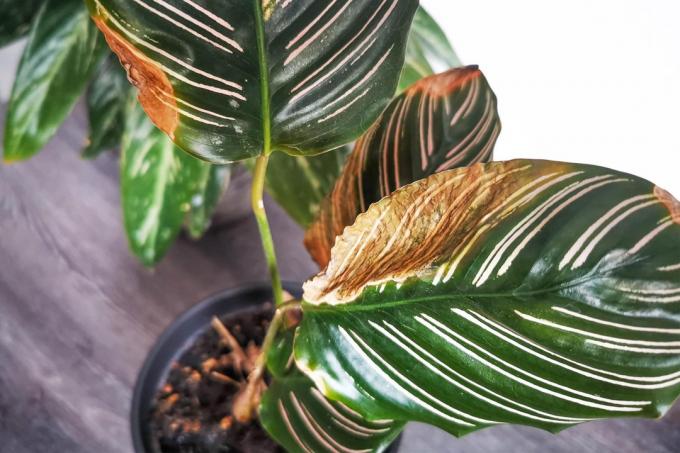

Table of contents
- Incorrect watering
- Incorrect fertilization
- Lack of humidity
- unfavorable temperatures
- Too much light during flowering
- Fixed location
If the Christmas cactus sheds its buds, this is usually a sign that the houseplant is not feeling well. Fortunately, the shedding of the flowers can usually be remedied in a few simple steps. Read here what they are!
Incorrect watering
Most cacti prefer it mostly dry. Not so the Christmas cactus, because it likes it a bit wetter than its relatives - especially when it is in bloom. If it doesn't get enough water, it may drop its buds. But be careful: Too much water is also not good for the houseplant, especially since waterlogging promotes root rot. With regard to watering, a certain amount of sensitivity is therefore required:
- Water about once a week
- Soil surface should dry between waterings
- Avoid waterlogging!
Tip:
It is best to check the substrate for dryness with a finger test. When the soil feels dry, it's time to water the houseplant.
Incorrect fertilization
Christmas cacti are best fertilized during the growing season from April to September. Because during this period they can use the additional nutrients directly. On the other hand, if they are fertilized for longer, they may drop their flowers. This is also the case, for example, if too many flower buds have already formed. In addition, fertilization from late summer has more of an effect on leaf growth than on bud formation.

Lack of humidity
In the wild, the Christmas cactus grows in the tropical forests of Brazil and therefore prefers moist air. This is not always the case in living rooms at home, because the indoor air is usually too dry, especially in winter. The lack of humidity ensures that the succulent loses its buds and the formation of the flowers suffers. However, the humidity can be optimized with just a few simple steps:
- Place saucers with pebbles and water under the plant
- Evaporation increases humidity
- Spray the plant with water 1-2 times a week
Info:
Dry indoor air is favored by air conditioning systems, heaters and draughty areas, among other things.
unfavorable temperatures
Christmas cacti prefer temperatures around 20 degrees Celsius during the growth phase. If it is too warm, there is a risk of overheating and dehydration. If, on the other hand, it is too cold, the plant sheds non-essential parts of the plant to protect itself. During flowering, succulents generally like it a little cooler. On the other hand, if it continues to be too warm, this will affect bud formation and the plants may drop their buds. For this reason, it is worth mimicking the seasonal temperature of their original home as follows:
- Lower temperatures during flowering
- 15 degrees Celsius is ideal
- Below 10 degrees Celsius is too cold
Too much light during flowering
Christmas cacti are short-day plants and require more darkness than light during bud formation. Therefore, the location should be dark for a long time during the flowering period, so that the light conditions of tropical rainforests are simulated. To the buds or To promote and avoid flowering, attention should be paid to the following from September:
- At least 14 hours of darkness per day
- For at least 6 weeks
- Ideally from September to November
- Light location the rest of the year

Although the houseplant prefers darkness during flowering, it should still receive enough light during the day. Sunlight is needed for bud formation. If there is too little light, the plant sheds flower buds. For this reason, the location should be bright for at least 10 hours during the day, although the blazing sun should be avoided.
Fixed location
The Christmas cactus quickly gets used to its location and the associated conditions. He does not like changes, which is why he is best not subjected to a change of location. The plant generally does not like being rotated or twisted. to be moved.
 Home editorial office
Home editorial office
Learn more about houseplants

16 cat-friendly houseplants
If you share an apartment with a cat, you should not have any poisonous indoor plants, because cats occasionally eat the greenery. There are many cat-friendly houseplants that are harmless and can recover quickly once a cat has bitten them.

Calathea gets brown leaves: how to save?
The foliage of a calathea, also known as a basket marante, has its price. And that doesn't mean the purchase price. The tropical plant wants to be cared for and feels like it is in its native rainforest. She expresses her dissatisfaction with unfavorable living conditions with brown leaves.

Monstera droops leaves: what to do?
Its serrated leaves make the Monstera one of the most popular indoor plants. But what can be the reason for it letting the leaves droop, and what can you do about it?

Water houseplants properly 15 tips for potted plants
Watering indoor plants properly sometimes turns out to be more difficult than expected. There are certain points you need to keep in mind when watering your indoor plants so they can show off their full glory. 15 tips on the subject can be found in this guide.

Efeutute, Epipremnum aureum: care from A - Z
The ivy or Epipremnum aureum is one of the most popular houseplants par excellence and is also ideal for people without a green thumb. You can find out how to care for the plant from A - Z here.

Purpurtute, Syngonium: care and propagation
The purple mare (Syngonium) is known as a fast-growing climbing plant with pure green, mottled, reddish or lightly variegated leaves. The numerous species not only differ in color, but also in the shape of their leaves, which changes with age.
